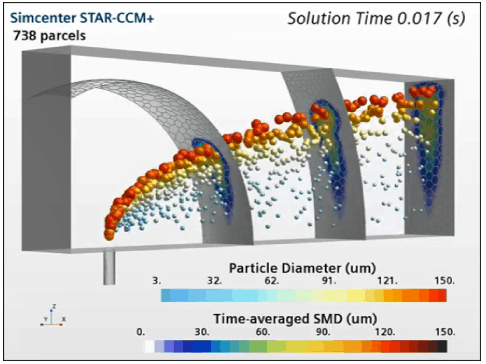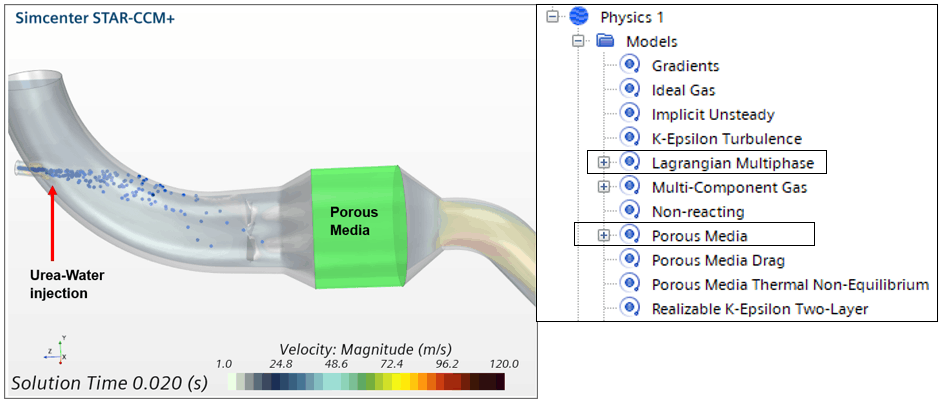This week, we will look at news related to Multiphase modelling for Simcenter STAR-CCM+ version 2020.3. We will look at news related to both the Eulerian and the Langrangian framework. And news relating to both fields in combination. There are some completely new models and model option possible that allows for simulations that was not possible before.
Eulerian multiphase
In the Eulerian framework we now have a VOF-to Langrangian transition model, and an MMP-LSI (Mixture Multiphase & Large-Scale Interface) model.
VOF-Langrangian resolved transition
The VOF-Langrangian resolved transition model is new tool to reduce the computational expense for VOF simulations. The transition is based on user criteria for VOF blob size. In gives not only reduced computational expense is VOF simulations but captures the smallest droplets in your simulation. Usually, even with AMR there will be a limit to how small the VOF-droplets can be before disappearing into numerical diffusion.
The new method can be combined with the AMR approach, and the refined mesh will, once the VOF-blob is removed, coarsen out, and the LMP droplet becomes sub-grid.
Applications where this can be of interest are Water management, Gearbox sloshing and for Fuel sprays. Further this implementation now allows for transition between several Eulerian framework sub-models. In the next example here, we look at cooling in an electric machine, VOF-jets are hitting windings, resolved VOF-fluid film transition occurs when there is not enough mesh for VOF. The fluid fil strips droplets into Langrangian Multiphase (red droplets). VOF breaks into droplets (VOF-LMP transition, shown in red). And last, both LMP phases can impinge back into both Fluid film and VOF. This gives full transition between different types of multiphase sub models.
Mixture Multiphase & Large Scale Interface (MMP-LSI) model
This new model effectively combines VOF and MMP. The VOF and MMP models has similar roots, but the VOF captures free surface without phase slip, while the MMP models phase slip without free surface. The idea here is to be able to increase the CFL number of your simulation and still maintain a relatively clear interface between phases, while being able to model under-resolved mixtures. One application here is gear lubrication, where this new model allows for faster simulation than pure VOF. The model was initially developed as a sub-model to Eulerian Multiphase (EMP). By making it available for MMP, this capability makes for the possibility of much less computationally expensive multiphase modelling.
In the clip below is a comparison of the new MMP-LSI model and VOF at two different CFL numbers. AT the top row, a CFL-number of 0.5 has been used and at the bottom a CFL number of 5. Both the VOF and the MMP-LSI model can resolve the issue at CFL=0.5. Introducing the MMP-LSI and maintaining that low CFL-number will increase the time it takes to obtain a solution for a specific CFL. But the point here is that for many engineering applications this level of resolution is not necessary. And the strength of this new model is that you can maintain a good enough capture of the free surface even at CFL=5. While the VOF model at CFL=5 completely dilute the interface, the MMP-LSI model resolves it. The conclusion here being about a five-time speedup going from VOF at CFL=0.5 to MMP-LSI at CFL=5.
Not only is there a speed up in certain types of simulation with this new model. It also provides a workflow for applications that previously was not viable. Below is an example of a multiphase pump, commonly used in the oil and gas industry. In this example the working fluid is a mixture of 90% water and 10% air. The fluid enters at the inlet as a homogenous mixture for which the MMP is suitable to capture. The body force of the rotating blades then causes the air to separate out of the water to form larger bubbles which are resolved by MMP-LSI. What this new method brings to the table is the ability to include bubbles and unresolved mixture simultaneously.
Another implementation giving speed up for VOF is the new compatibility with PISO. The PISO solution algorithm is typically 1.5-3x faster than SIMPLE for small time-steps, typically the case for VOF simulations at CFL<1.
Langrangian multiphase
While the Eulerian framework was given a couple of large new models, the Langrangian framework has received some major relevant updates as well.
Boundary sample data mapper
The boundary sample data mapper now provides a method to time-integrate or time-average any particle property of particles passing through or interacting in any other way with a boundary. This previously required scripting and analysis in a 3rd part tool outside Simcenter STAR-CCM+. This implementation is useful to obtain time-averaged spatial distribution of Sauter Mean Diameter of evaporating droplets at specific distances from the nozzle. The picture below shows an example of this, where all particles that pass through the internal interface and outlet boundary contribute to the statistical analysis of particle size on the boundaries.

Langrangian multiphase support of Porous Media Model
Previously users could only use the Porous Region type under the Region settings, to simulate for instance Selective Catalytic Reduction and other applications with particles together with porous media. As of version 2020.3 you can now activate the Porous media model in the physics continuum. With the porous media approach, as opposed to the porous Region method you now have the option of choices for porous media energy models. You can also select porous media drag model and to define multiple porous phases, set User Defined Equation of state for solid material of Porous Media. You can also now add Electrochemistry or Electromagnetism models to the porous media regions.

Source smoothing for droplet impingement into VOF
When running hybrid multiphase simulations within Simcenter STAR-CCM+, different physics models may require different mesh size to provide the best accuracy and convergence. In this situations, the cell clustering approach has already proven to be very effective to handle two different length scales requirements in the single simulation and improve convergence for 2-way coupling between Langrangian and Eulerian phases. New to the latest version is that source smoothing using cell clustering is utilized in VOF-Langrangian impingement model. This provides stability to cases where the Langrangian particle has a mass larger than the largest mass able to fit in a cell. Here now, the mass of impinging LMP droplet is transferred to all the cells of the cell cluster hosting impingement event. This improvement is not a model selection or a setting but is automatically applied to all simulations.
Additional Langrangian updates
In addition to the previously mentioned updates, there has been some minor updates worth mentioning as well. The Rosin-Rammler exponent for particle size distribution can now be set as a parameter (see the left picture). This enables calibration of particle size distribution parameters using Design Manager.
There is also a new particle enthalpy field function (see middle picture). It is useful for evaluating energy component of Langrangian Impingement source when specific heat of liquid or gas material is specified through polynomial field function method.
There now also exists flux-based choices for the flow rate specifications in injectors injecting DEM particles (see the right picture).

I hope this week’s read has been helpful to you in realizing your CFD-dreams and as usual, do not hesitate to reach out at support@volupe.com, if you have any questions.
Release update on Simcenter STAR-CCM+ reading
Simcenter STAR-CCM+ version 2020.3 news – Part 1
Simcenter STAR-CCM+ version 2020.3 news – Part 2
Release of Simcenter STAR-CCM+ 2020.2 part 4
Simcenter STAR-CCM+ version 2020.3 news part5